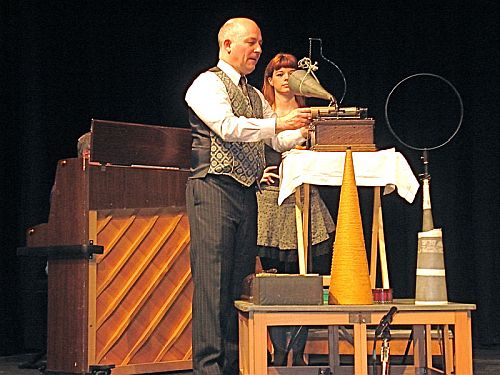 United Kingdom Early Recording Techniques, (the Vulcan Cylinder Record Company), Duncan Miller, Buxton International G&S Festival,The Pavilion Theatre, Buxton, , 2.8.12 (RJW)
United Kingdom Early Recording Techniques, (the Vulcan Cylinder Record Company), Duncan Miller, Buxton International G&S Festival,The Pavilion Theatre, Buxton, , 2.8.12 (RJW)

With the latest iPod technology just round the corner it is easy to forget the toil of those early sound engineers that made recording possible. An early London demonstration of Edison’s phonograph happened in 1888 at a dinner where British celebratories were gathered. Some of the guests were invited to record their voice and Sir Arthur Sullivan was one who accepted the challenge, lamenting in his speech of how the future would preserve music however badly played.
Dr Duncan Miller, ably assisted by Jenny Bland, brought an array of phonographs, cylinders and horns to whet our appetites for this forgotten journey of discovery, an art of preserving sound waves in the aspic of ‘hill and dale’ modulated grooves for future generations to hear. To appreciate the difficulties of the recording process Dr Miller set up recording studio conditions c. 1900 and invited a pianist and singers amongst the audience to ‘have a go’ on blank cylinders prepared for the occasion. A test recording to check voice loudness and singer position showed that there was considerable fall-off if standing away from the horn. This was the major difficulty in those pioneering days since the players of a band could not all be expected to stand in the same focal position.
Four G&S numbers; ‘Tit Willow’ (sung by Mr Neil Smith), ‘O happy Young Heart’ (sung by Miss Rachel Middle), ‘When the Foeman bears his Steel’ (sung by Mr John Savournin and chorus), and ‘Dance the Cachucha’ (chorus) were each recorded on 2 minute cylinders. Despite the closely placed piano, it sounded very distant, yet the voices were good and the recordings were unbelievably crisp and clear. The freshness of the cutting produced no crackles or clicks in reproduction, but very noticeable flaws with out-of-tune voices made one realise the difficulty in getting those Edison, Sterling and Columbia cylinders of the early 1900s recorded to a decent standard.
Early wax cylinders were vulnerable to damage but over the decades brought improvements and today Dr Miller (who duplicates cylinders of rare recordings for sale by his Vulcan Cylinder Record Company) uses a steric acid compound which is harder, more durable and gives excellent frequency results in its soapified form. The results are outstanding.
A mystery of how the early phonograph companies could duplicate a cylinder with ridges in a mould was explained. The moulded cylinders can be removed because the compound shrinks by around 4% as it cools and the cylinders are also slightly tapered. Before this technique was invented each cylinder cut had to be an original. A singer would record up to 20 cylinders in a day, some performances being better than others. The duplication problem was better solved when Berliner invented the flat disc record in 1887 with mass production not being a problem. It is interesting to note that Sullivan’s London speech dinner was held in 1888, so was Edison attempting to steer the English to an acceptance of his system before Berliner could show them his? Interesting!
Raymond J Walker